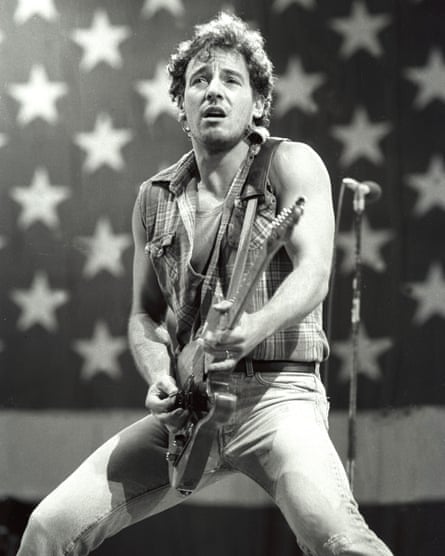Springsteen is aware of his limitations
You might think someone who has headlined stadiums since 1984 would be convinced of his own musical abilities, but no. When he formed the Castiles, 50 years ago, “I was considered toxic in front of a microphone,” he writes. And while he reckons he’s competent now, he doesn’t stretch much further than that: “I have a barman’s power, range and durability, but I don’t have a lot of tonal beauty or finesse … My voice gets the job done. But it’s a journeyman’s instrument and on its own, it’s never going to take you to higher ground. I need all my skills to get by and to communicate deeply … I am a sum of all my parts. I learned early that this is not something to fret about.” While this might not come as much of a surprise to those for whom Springsteen’s full-on mode – that wounded-bullock bellow of his biggest rock song – is a stumbling block, it is still shocking to hear one of rock’s most admired and longstanding stars, whose debt to soul and R&B is so transparent, admit it’s the case.
Whatever his relationship with his dad, he was always looking for father figures
Springsteen’s troubled relationship with his father, eventually resolved long into adulthood, is an ongoing theme of Born to Run. In the absence of a father who supported him, he sought encouragement and advice from a series of men he admits were “surrogate father figures”, beginning in his teens with Tex Vinyard in his hometown of Freehold, New Jersey. Tex and his wife Marion let local teen bands practise in their home. “He was loving in his own twisted way,” Springsteen writes. “More important, he was accepting. He cherished and encouraged your talents, took you for who you were and put his time, muscles, money and big black Cadillac, hauling equipment, all in service of your dreams.” Those father figures crop up several times, until the most important of all arrives in Springsteen’s life – Jon Landau.
When the facts become legend, Springsteen prints the legend
One of the key moments in Springsteen’s career is one of the most misinterpreted. In May 1974, Landau – at that point a rock writer who’d had an unsuccessful bash at being a producer, and who was undergoing a crisis of faith in rock music, wondering if he had a place within it – reviewed a Springsteen show in Cambridge, across the River Charles from Boston. “Last Thursday, at the Harvard Square theater, I saw rock’n’roll past flash before my eyes,” Landau wrote. “And I saw something else: I saw rock and roll future and its name is Bruce Springsteen. And on a night when I needed to feel young, he made me feel like I was hearing music for the very first time.” Landau was writing not that he had seen the future course of music, but that he had seen he and rock had a future together. The quote was transformed, until Springsteen became the subtly different “the future of rock’n’roll”, a quote that followed him around and boosted his reputation. It was, as Springsteen writes in Born to Run, “one of the greatest lifesaving raves of all time”, and he acknowledges what Landau was really writing about and how “it has always been taken somewhat out of context, its lovely subtleties lost”. And yet, when he introduces the quote, he doesn’t cite the actual words, writing instead: “A man in Boston had ‘seen the future of rock’n’roll’, and it was … me.” A small thing, but given how crucial the quote was, an important thing.

Springsteen often had problems with women
While he realised early on that music was a way to meet girls – that even a gawky kid could stir interest if he was willing to shake it up on the dancefloor, or hold a guitar on a stage – Springsteen was so consumed by his music that he didn’t have a lot of time for women. And when he did, he says, he didn’t behave well. He accepts he handled his separation from his first wife, Julianne Phillips, appallingly. But there’s more to it than that, and he traces it back to the personality traits he inherited from his father: “A misogyny grown from the fear of all the dangerous, beautiful, strong women in our lives crossed with the carrying of an underlying physical threat, a psychological bullying that is meant to frighten and communicate that the dark thing in you is barely restrained. You use it to intimidate those you love … I can’t lay it all at my pop’s feet; plenty of it is my own weakness and inability at this late date to put it all away.”
The E Street Band could never be simply a band of brothers
Of course, Springsteen was always the boss – as well as The Boss – but there’s more to it than that, and it lies in the complicated status of Clarence Clemons, saxophonist and onstage foil, the best-paid member of the band, and its beating heart. “He struggled living in the predominantly white world of our band,” Springsteen writes. “For a long time he was alone, and no matter how close we were, I was white. We had as deep a relationship as I can imagine, but we lived in the real world, where we’d experienced that nothing, not all the love in God’s heaven, obliterates race.” There’s a telling moment in Born to Run, when the E Street Band join the 1988 Human Rights Now tour promoting Amnesty International. One of the stops is in Cote D’Ivoire, where the band play to “an audience, a stadium audience, of completely black faces! I finally knew how Clarence felt.”

Comments (…)
Sign in or create your Guardian account to join the discussion